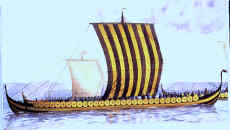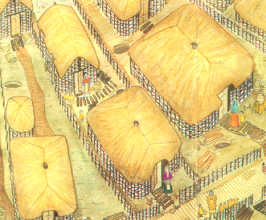Vikings
The Vikings came to Ireland as adventurers. Beginning in 795 AD, they raided along the coast and up the rivers, often targeting the monasteries, many of which were by now storehouses for fabulous treasures. Fine metalwork in the Irish style has been found in the graves of Scandinavian women, no doubt brought back to them as gifts by their sea-faring men.The Vikings made settlements at the mouths of rivers at Dublin, Wexford, Waterford, Limerick and other places, using them at first as bases for raiding and trading.
Archaeological excavation in Ireland, especially at Wood Quay in Dublin has provided a unique insight into life in a Viking settlement. An exciting collection of artefacts used by ordinary Viking people in everyday life can be seen in the Viking display at the National Museum of Ireland in Dublin. They include items as personal as a child's shoe, pieces of silk ribbons, hairnets, bonnets, a toy boat, as well as a slave chain with a neck ring.
The Vikings brought slaves from abroad to Ireland and also took Irish women and men as slaves.
... Howth in Dublin Bay. An attack there in AD 821 saw the raiders make off with a large number of women captives (Praed mor di mnaibh do brid as. Was this a nunnery?).
Dáibhí Ó Cróinín, Early medieval Ireland 400-1200, London, 1995, p. 236. |
|
|
|
Roskilde ship
Artist's impression of a ship made in Dublin
and excavated in Denmark
Viking Ship Museum, Roskilde, Denmark
|
|
Most of the Viking houses excavated were rectangular, The walls were made of wattle and the fireplace was central, the smoke going out through a hole in the roof. The floor space was divided in three with a centre aisle separating two rows of raised benches which served both as seats and beds. The pathways and the fences around the houses were also made of wattle.
Much refuse was found both in the houses themselves and around them.
Artist's impression of Viking Dublin
National Museum of Ireland
|
|
The Vikings brought luxury items to their bases in Ireland, such as amber from the Baltic and pottery, silk and ivory from farther afield and archaeologists have found traces of imported figs, raisins and walnuts in their refuse. However, the Viking settlements depended on the Irish in the surrounding countryside for wattle, timber and most of their food. Excavation shows that they used fruit, oats and barley and that they ate the meat of cattle, sheep, goats and pigs, some of which they reared themselves. They also ate goose, duck and a great variety of fish. Vessels such as bronze buckets, bowls, strainers and drinking horns have been found.
Articles found in the graves of Viking women in Ireland included beads, pendants, ear-rings, finger rings and combs, as well as objects associated with textile trades. A Viking woman wore a long linen undergarment and a woollen dress suspended from shoulder straps which were pinned with brooches. A shawl for outdoors was fastened with another brooch. A Viking man wore a shirt, trousers and tunic and had a cloak for outdoors. Males were often buried with their swords, spears and shields.
Tuirgéis, a Viking leader plundered the monasteries on the Shannon in the mid ninth century and his wife Ota was said to have taken over Clonmacnoise and to have issued 'magic spells' from the high altar. Eventually the Vikings intermarried with the Irish and women were often married off as pawns in the schemes of powerful families on both sides. Several distinguished Icelandic families still trace their ancestry back to three Irish women who married Norsemen and who were descendants of Cerball, a ninth century king of Ossory.
An Irish woman called Gormlaith provides us with an example of complicated intermarriage. The daughter of the king of Leinster, she was married first to the elderly Olaf, Viking king of Dublin. Then she became the wife or mistress of the powerful Maelsechnaill II, king of Meath. Next, she married Brian Ború, king of Munster who fought against Sitric Silkenbeard, her son by Olaf, at the Battle of Clontarf, 1014. To complicate matters further, Sitric had married a daughter of Brian Boru by a previous alliance.
In Icelandic tradition she is portrayed as a grim and scheming lady who plays men off against each other in her ruthless quest for vengeance against Brian Boru, and ... was alleged to have been 'the fairest of all women' ... Gormlaith may or may not have had good looks, but she did have the royal blood of countless generations of Leinster kings in her veins, and it was this which earned her a place in the beds and counsels of three of the most famous kings of medieval Irish and Scandinavian tradition.
Alfred P. Smyth, Celtic Leinster, Dublin, 1982, p. 83. |
But many Vikings of lesser importance settled down peacefully, even sharing the Gaelic custom of fosterage, trading and intermarrying with the Irish and eventually blending into the local population.
|
Temple Bar living in 1000 AD
Even then ... the most fortunate, the wealthy merchants lived in Christchurch [Dublin]. The middle classes, the higher skilled craftsmen lived in Temple Bar.
Boats came and went on the Liffey, carrying the fruits of trading and raids, including slaves.
Most of the houses were lumped together to save space and roads were, in fact, wattle-covered paths perhaps only five feet wide. Each house, however, had a significant sized garden of almost uniform size, usually around 80 ft long ... Each garden had a wattle path running to a pit at the end into which all the family waste was pitched.
... At least half of all men in the area would be away at sea for half of every year, trading between ports and perhaps raiding ... Temple Bar dwellers wore leathers and skins as well as rough woven-linen clothes.
Most people had livestock such as goats, pigs and sheep ... Cattle were kept on commonage such as Hoggen Green (now College Green). Temple Bar dwellers ate plenty of meat, roasted and boiled. They also ate greens like nettles and dandelions, goats' cheese, fish and much of their food was an 'all in' gruel or soup made from whatever was handy, laced with barley. Meat and fish were dried and cured for the winter.
Houses were smoky and dank and people ate with their hands from earthenware pots and wooden plates. The floors were covered in earth and lined with straw which was changed regularly. People slept on skins around the fire. Walls of double post wattle provided shelter.
The average Temple Bar dweller of a thousand years ago could expect to live well into their late 40s, a lifespan which equated pretty much to that of the Dublin city dweller in the early 1900s.
Extract from Sunday Tribune, 27 February 2000.
|
Questions
- Archaeological excavation at ______ _____ in Dublin has given a unique _____ into life in a ____ settlement.
- In your own words, briefly describe a Viking house.
- Describe the appearance of a Viking woman.
- Describe the appearance of a Viking man.
- Why did the Vikings mix with the native Irish?
- What reasons does Alfred P. Smyth give for Gormflaith's marriages to three powerful leaders?
- Suggest three important implications for Viking women of men being absent half of every year?
Activities
- Draw or make a model of a Viking house.
- Role play a conversation between a woman living in a Viking settlement and a native Irish woman living in the countryside.
- Pretend to be a Viking woman living in Temple Bar and write a letter home to a friend in the Isle of Man, York, Scotland or Scandinavia describing your street, house, clothes and food.
- Discuss the following topics:
- Women in a warrior society
- Women members of powerful families
- Women living in medieval towns
- The special problems and challenges Viking women might face in settlements far from home.
- Research the Vikings in the local history of your own area.
- Organise a visit to the display of Viking culture at the National Museum of Ireland, Dublin and/or to the exhibition 'Dublin's Viking Adventure'.
- Refer to the Irish Annals on the Internet or in book form to research one or more women, especially in the ninth and tenth centuries during the Viking period.

